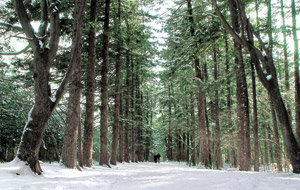Just Like the Tall-Stretched Trees My Heart Grows
Just Like the Tall-Stretched Trees My Heart Grows
Posted February. 18, 2004 23:24,

Naeso Temple with snow. The scenery is the one where I could see in my daydreams of yesterday. The fir trees lined along the 400-meter trail are part of the image that I had in my dreams. The dream and the daydream are realized right in front of my eyes, and the scenery overwhelms me.
After the One Pillar Gate into the temple is more of the road lined with fir trees as high as 30 meters. Even in the wintertime, as well as the summertime, one cannot see the sky above on this road. The thickness of the trees creates darkness in the middle of the day. After snow, the forest was covered all with snow. The snow fluttered around the branches of the trees and finally landed on the ground. The snow under the forest is as thick as that outside the forest. I thought the snow cannot land on this ground because of the dense covering of trees, but the trees could not stop the snow falling down on the ground, which is teaching me again that there is nothing in the world that cannot work against the natural laws.
Gwaneum Peak of Mt. Naebyon, 433 meters above sea level. The 1,000-year-old Naeso Temple has eccentric-looking rocks around the peak, as if the skirt of a fairy trailed by. I have come to the beauty of the temple all this way, but it still did not reveal its face after walking several hundred meters after the One Pillar Gate. The only thing I saw was the Four Guardians Gate standing on staircase-high cornerstones. I was led by the guardians and came to see the face of the temple after passing the Guardians Gate.
Halls and shrines surround the front yard of the temple. A 1000-year-old zelkoba tree greets visitors standing 20 meters high. The temple was constructed in the 633 during the Baekje Dynasty, so only it knows what had happened to this land all those years. I bow to its strength and infinity all those years.
The temple is saying farewell to the winter. It is so quiet that I cannot believe it is during the day. The only things I can hear are singing of mountain birds and wind-bell chimes. Silence rules the land. It is so quiet that the sound of the wooden gong can be even heard over the sea by Byonsan, away and away. People with wide eyes can see flowers in the snow bed. The flowers are in bloom on the lattice of the main halls doors. These can be seen in any other temples, but the ones here in the Great Hero Hall of this temple are more special. All eight pieces of the doorframes are adorned with the elegant flower patterns in bloom.
The major peak of the mountain is Uisangbong, 509 meters high above sea level. The geographical protrusion toward the sea starts from this peak. The area has both the mountains and the sea, but it has all the core beauties of them, too. The mountains and the sea give it breathtaking scenery all around the area. In mid-summer, the wind blows by the arms of the pine trees and raindrops fall on the arms of the fir trees. Also, one finds the world around has turned white overnight when opening the door in winter mornings. These are the descriptions for Mt. Naebyon. Mt. Oebyeon has also its own descriptive words: sailing ships with golden robe sails are sailing into the port when the sun is setting, while one can hear the sounds of the big drum from the Naeso Temple.
From the temple, I head for the sea by Mt. Oebyon. The Byonsan Sea, which starts from the tip of the peninsula, is also silent. The broad and wide estuary slits have swallowed the sounds and create a silence. Compared to the East Sea, where the wild waves roar, this is a lake here.
The Byonsan coastline is where the inner and the outer, the mountain and the sea meet together. The coastline is complicated that way. It protrudes here and caves in there. National road No. 30 leads around the coastline. The curves are elegant. The sea reveals its many different faces every time I steer to different directions on its curves. The water tides out and exposes naked silt, creating a whole different scene of the sea. It is a special scene, where the waterline is above the skyline. Another scene where the sea is divided by a huge embankment attracts pity.
Port Kyokpo is the central land of Byonsan Peninsula. Yellow flags are flapping in a line along the breakwater. There are more of the yellow flags upon a lighthouse at the seaside end of the breakwater. The residents are demonstrating against the construction of nuclear waste depot in Wedoh. Chaesok River is located side by side with the breakwater. Layers of red rock wall look as if they are books piled up. The inharmonic scenery of this, along with dull grey concrete buildings nearby, marks the height of the destruction of nature. What would be the color of the flag that turned up in the residents minds when stepping on the breakwater that ruined the Chaesok River?
I walk into Unpo village nearby. The village is quite amusing with rockworks around the beach and planted pine trees on them. The facilities there are for teachers, and thus they changed the name of the beach to Evergreen Beach. The beach can be only visited once a year.
A village near Port Gung was much more jolly. It is a small port village with fishing boats floating nearby. Old houses with low roofs surround the coastline. The slogans and paintings against the Wedoh nuclear waste depot are also familiar.
I wished for one thing upon leaving Byeonsan. I hope that this friendly place does not change for a long time. Another thing: I hope I have gained some wisdom in learning from Byeonsan, where the extremes of mountains and the sea meet and embrace each other in tolerance, as well as any other people who might step into this area.
summer@donga.com







